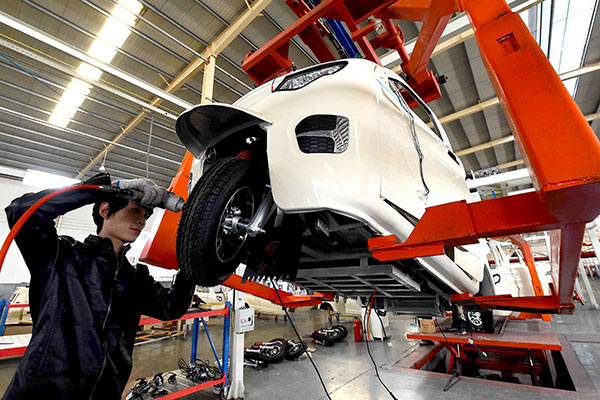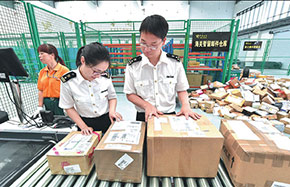Manufacturing sector expansion cools
 |
|
A worker readies an electric car at a production line in Weifang, Shandong province. WANG JILIN/CHINA DAILY |
The PMI, a gauge of factory conditions, stood at 51.6 in October, the NBS said in a statement on its website. It was 52.4 in September, which marked a five-year high. A reading above 50 is deemed as expansion and one below that mark indicates contraction.
The manufacturing sector of the world's second-largest economy remained on track for expansion since the October reading was above the demarcation mark of 50, said Zhao Qinghe, a senior statistician of the NBS, in a statement. "Despite the retreat, the indicator was still 0.4 percentage points higher than a year ago and remained at the average level for this year."
Zhang Liqun, an economist of the State Council's Development Research Center, said the falling index in October is not to be worried about. "It remained above 50, indicating that the economy has shown a more entrenched trend of stable growth."
The weeklong National Day holiday in early October affected production and new orders growth, and activities in the energy-consuming and pollution-intensive industries also slowed due to the country's crackdown on pollution in some regions, Zhao of NBS said.
He said the PMI for exports and imports, which was 50.1 and 50.3, respectively, and had remained above the 50 mark for 12 consecutive months, showed that China's manufacturing foreign trade remained expansionary.
The PMI for advanced manufacturing and consumer goods manufacturing was also in the expansionary zone, he added, indicating that the country has continued to make headway in its supply-side structural reform, which has benefited such industries as auto making, special equipment manufacturing and pharmaceuticals.
The falling PMI in October indicates that demand remained lackluster and economic activities were weak at the start of the fourth quarter, said Jiang Chao, an analyst with Haitong Securities. "The economy may weaken in the short term."
China registered a year-on-year GDP growth of 6.8 percent in the third quarter, with combined growth in the first nine months coming in at 6.9 percent. Analysts forecast that the economy could slightly weaken in the last quarter of this year, but will probably maintain a stable growth momentum.
Qiu Xiaohua, chief economist with China Minsheng Securities, said that China's economic slowdown cycle has almost come to an end, as shown by the strengthening of major economic indicators in recent months, especially from the manufacturing sector.
The emerging economic recovery marks the beginning of a new economic cycle, he said.
China's recent monetary policy of fine-tuning toward more prudence other than money supply increases has pointed to policymakers' confidence in tackling long-term development challenges instead of stimulating short-term expansion as the economy is expected to further stabilize, Qiu added.
He said the country's GDP growth will remain stable between 6.5 to 7 percent in the following three years without major fluctuations.
- Advanced manufacturing advances GDP of Guangdong, Jiangsu
- China's manufacturing PMI softens in Oct
- China promotes Internet Plus manufacturing to boost innovation, competitiveness
- Rise of automatic machines facilitates intelligent manufacturing
- Sino-German Ecopark: a creative leap from manufacturing to intelligence


















